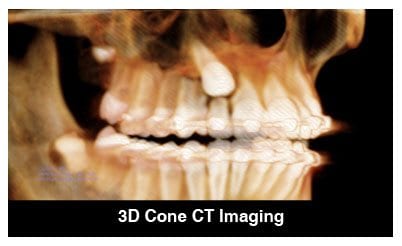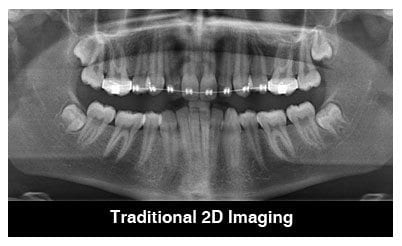The state-of-the-art surgical center at The Maryland Center for Oral Surgery and Dental Implants features the latest innovative technology, including digital radiography and digital impressions. These technologies are brought to the residents of Baltimore to improve the quality and comfort of patients receiving dental implants and oral surgery.
3D Cone Beam Imaging
The facility at The Maryland Center for Oral Surgery and Dental Implants utilizes i-CAT 3D cone beam imaging to enhance patient care.
3D beam imaging is an important advancement in the use of imaging for dental implants and dental work. The more anatomical information available to the dentist, the better diagnosis and treatment the dentist can provide. 2D images just cannot capture the level of complete detail that is possible with 3D. The 3D computer-generated scans provide an advanced and detailed look at existing teeth, bone, nerves, and tissue with three-dimensional and cross-sectional views. These advanced views provide critical diagnostic information.


Patients who come into the Baltimore office for dental implants or oral surgery consultations will receive these 3D image scans. The dentist will…
- Evaluate the quality, width, shape, and density of the bone where the dental implants will be placed.
- Determine the proper treatment approach for each individual
- Determine the precise placement of implants, particularly in areas near critical anatomical structures such as sinuses and nerves.
- Select the correct style and size of the implants.
The i-CAT scanning system provides fully 3D scans that eliminate the need for offset scanning and maximize the use of large singular sensors. i-CAT is recognized in the dental work industry as affordable, safe, powerful, and easy to use for dental professionals of all types. In addition, the system is very safe and delivers a normal radiation dosage of similar strength to a traditional 2D scanning image. The actual i-CAT scan time is only about 20-40 seconds, and it takes the computer about one minute to build the images, so the process is fast as well. Dental implant scanning doesn’t have to be demanding and imprecise anymore with i-CAT 3D cone beam imaging.
Digital Impressions
In addition to the wonders of 3D imaging, the practice at The Maryland Center for Oral Surgery and Dental Implants can now streamline treatment sequence for dental implants and reduce the number of appointments necessary to complete the final restoration with new digital impressions technology.
The iTtero Digital Impression System makes it possible to obtain highly accurate virtual impressions of teeth, eliminating uncomfortable, goopy putty and tray impressions that cause gagging and discomfort for many patients.
These digital impressions are fully explorable models of the teeth. There will be no need for a secondary appointment to gather impressions, and the precision of this system also means fewer adjustments when it is time to seat the final restoration, which often results in a shorter appointment.
X-Guide
Our surgeons use digital technology to place dental implants with a higher level of accuracy and precision. Digital impressions using Trios 3- Shape are merged with 3-D Conebeam technology and the X-guide to facilitate implant placement. X-guide is a sophisticated tool that allows us to map implant placement carefully and precisely in advance, reducing surgical times, minimizing errors while obtaining predictable and consistent results.
Contact The Maryland Center for Oral Surgery and Dental Implants for more information about the advanced technology used to treat and diagnose Baltimore patients. Call in to schedule a consultation or visit any of the offices today.

